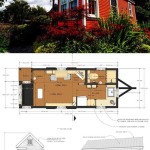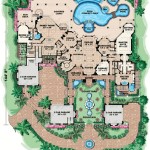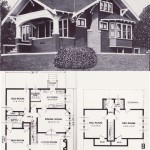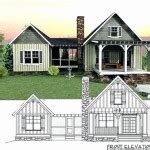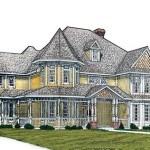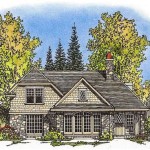An open concept house plan is a design that eliminates traditional barriers between rooms, creating a spacious and interconnected living area. Instead of separate rooms for the living room, dining room, and kitchen, these spaces are combined into one large, open area, allowing for greater freedom of movement and interaction.
Open concept house plans are particularly popular in modern homes, where they promote a sense of openness, brightness, and community. For example, a homeowner may choose an open concept design to facilitate seamless transitions between the living room, where they can relax and entertain, and the kitchen, where they can prepare meals while still being part of the conversation.
In the following sections, we will explore the benefits and challenges of open concept house plans, discuss different types of open concept designs, and provide tips for maximizing the functionality and aesthetic appeal of these spacious living spaces.
Open concept house plans offer numerous advantages, including:
- Increased natural light
- Improved flow and space
- Enhanced family interaction
- Easier entertaining
- More efficient use of space
- Boosted sense of spaciousness
- Modern and inviting aesthetic
- Greater flexibility for future renovations
However, it’s important to note that open concept plans also come with some challenges, such as the need for careful space planning and the potential for noise and distraction.
Increased natural light
One of the major benefits of open concept house plans is increased natural light. By eliminating walls and partitions, open concept designs allow for more windows and larger windows, which can flood the living space with natural light.
This natural light has numerous benefits, including boosting mood and energy levels, reducing the need for artificial lighting, and creating a more inviting and welcoming atmosphere. Additionally, natural light can help to reduce eyestrain and improve sleep quality.
In open concept homes, the natural light from windows in one area can penetrate into other areas, creating a brighter and more spacious feel throughout the entire living space. This is especially beneficial in homes with northern exposure, where natural light can be limited.
To maximize the benefits of natural light in an open concept house plan, it is important to carefully consider the placement of windows and doors. Architects and designers can use tools like sun studies to determine the optimal placement of windows to take advantage of natural light throughout the day and seasons.
Improved flow and space
Open concept house plans are known for their improved flow and space. By eliminating walls and partitions, these designs create a more spacious and interconnected living area, allowing for greater freedom of movement and interaction.
One of the main advantages of improved flow is the ability to move around the living space more easily. This is especially beneficial for families with children or individuals with mobility issues. In traditional homes with separate rooms, moving from one room to another can be disruptive and time-consuming, especially if carrying items or assisting others.
Open concept designs also make it easier to reconfigure the furniture and dcor to suit changing needs and preferences. Without the constraints of walls, furniture can be arranged in a variety of ways to create different seating areas, activity zones, and traffic patterns. This flexibility allows homeowners to adapt their living space to their evolving lifestyle and needs.
In addition to improving flow and space, open concept designs can also create a more cohesive and inviting atmosphere. By visually connecting different areas of the living space, these designs promote a sense of community and togetherness. This is especially beneficial for families and individuals who enjoy spending time together and interacting with each other.
Overall, the improved flow and space offered by open concept house plans contribute to a more comfortable, functional, and enjoyable living environment.
Enhanced family interaction
One of the key benefits of open concept house plans is enhanced family interaction. By eliminating walls and partitions between the living room, dining room, and kitchen, these designs create a more connected and inviting space where families can spend quality time together.
In traditional homes with separate rooms, family members may be isolated from each other, especially if they are engaged in different activities. For example, a parent cooking in the kitchen may be separated from children playing in the living room or a spouse watching TV in the den. This can lead to a lack of communication and interaction, which can be detrimental to family relationships.
Open concept house plans break down these barriers and promote family interaction in several ways. First, they allow family members to see and hear each other more easily, even when they are in different areas of the living space. This facilitates casual conversations, impromptu games, and spontaneous moments of connection.
Second, open concept designs encourage family members to participate in shared activities. For example, children can help set the table while their parents cook dinner, or the whole family can gather in the kitchen to bake cookies together. This shared space fosters a sense of togetherness and cooperation, and it creates opportunities for families to bond and create lasting memories.
Easier entertaining
Open concept house plans are ideal for entertaining guests. The open and interconnected layout allows for easy flow of traffic, making it simple for guests to move around and mingle without feeling cramped or isolated.
One of the key advantages of open concept designs is the ability to host large gatherings without feeling overwhelmed. The spacious living area can accommodate a significant number of guests comfortably, providing ample space for seating, dining, and socializing. Additionally, the open layout allows guests to move freely between different areas of the living space, such as the kitchen, dining room, and living room, without feeling confined to one specific area.
Another advantage of open concept house plans for entertaining is the ease of serving and socializing. The open kitchen design allows the host to prepare food and drinks while still being part of the conversation and activities in the living and dining areas. This eliminates the need for the host to retreat to a separate kitchen, which can often lead to feelings of isolation and missed opportunities for interaction.
Furthermore, open concept designs promote a more relaxed and casual atmosphere, which is ideal for entertaining. Guests can feel comfortable moving around, helping themselves to food and drinks, and engaging in conversations with different people throughout the living space. This creates a more convivial and welcoming atmosphere, encouraging guests to stay longer and enjoy themselves.
Overall, open concept house plans offer numerous advantages for entertaining, making them a popular choice for homeowners who enjoy hosting gatherings and creating a warm and inviting atmosphere for their guests.
More efficient use of space
Open concept house plans promote a more efficient use of space by eliminating unnecessary walls and partitions, which can create a sense of spaciousness and openness. This efficient use of space offers several benefits, including:
- Reduced wasted space
Traditional house plans often have separate rooms for the living room, dining room, and kitchen, which can result in wasted space in hallways, doorways, and unused corners. Open concept designs eliminate these wasted spaces by combining these areas into one large, open living area.
- Increased flexibility
Open concept house plans offer greater flexibility in terms of furniture placement and room usage. Without the constraints of walls, furniture can be arranged in a variety of ways to create different seating areas, activity zones, and traffic patterns. This flexibility allows homeowners to adapt their living space to their evolving lifestyle and needs.
- Improved flow and circulation
The open and interconnected layout of open concept house plans allows for better flow and circulation of traffic. This improved flow makes it easier for people to move around the living space, especially when carrying items or assisting others. It also reduces the likelihood of bottlenecks and congestion, creating a more comfortable and functional living environment.
- Enhanced natural light
By eliminating walls and partitions, open concept house plans allow for more windows and larger windows, which can flood the living space with natural light. This natural light not only reduces the need for artificial lighting but also creates a more inviting and welcoming atmosphere. Additionally, natural light has been shown to have positive effects on mood, energy levels, and productivity.
Overall, the more efficient use of space in open concept house plans contributes to a more spacious, flexible, and comfortable living environment.
Boosted sense of spaciousness
Open concept house plans are known for their ability to create a boosted sense of spaciousness, making even small homes feel larger and more inviting. This sense of spaciousness is achieved through several design elements, including:
- Elimination of walls and partitions
The most significant factor contributing to the boosted sense of spaciousness in open concept house plans is the elimination of walls and partitions between the living room, dining room, and kitchen. This creates a large, open living area that feels more expansive and airy than traditional homes with separate rooms.
- Abundance of natural light
Open concept house plans typically feature more windows and larger windows than traditional homes. This allows for an abundance of natural light to flood the living space, which further enhances the sense of spaciousness. Natural light has a way of making rooms feel larger and brighter, creating a more inviting and welcoming atmosphere.
- High ceilings
High ceilings are another common feature of open concept house plans. High ceilings draw the eye upward, creating a more vertical sense of space. This makes the room feel taller and more spacious, even if the square footage is relatively small.
- Decluttered and minimalist design
Open concept house plans often lend themselves to a more decluttered and minimalist design aesthetic. This is because the open and interconnected layout makes it more difficult to hide clutter and unnecessary items. As a result, open concept homes tend to have a more streamlined and spacious feel.
Overall, the combination of these design elements creates a boosted sense of spaciousness in open concept house plans, making them ideal for homeowners who want to create a more expansive and inviting living environment.
Modern and inviting aesthetic
Open concept house plans are characterized by a modern and inviting aesthetic that appeals to many homeowners. This aesthetic is achieved through several key design elements, including:
- Clean lines and simple forms
Open concept house plans often feature clean lines and simple forms, which create a sense of order and sophistication. This minimalist approach to design emphasizes the beauty of the home’s architectural features and allows the furniture and decor to take center stage.
- Neutral color palettes
Neutral color palettes are commonly used in open concept house plans to create a sense of spaciousness and tranquility. These neutral colors, such as white, beige, and gray, provide a backdrop that allows the homeowner’s personal style to shine through in their furniture, artwork, and accessories.
- Natural materials
Natural materials, such as wood, stone, and leather, are often used in open concept house plans to add warmth and texture to the space. These materials bring the outdoors in and create a connection to nature, which can be especially appealing to homeowners who value sustainability and organic living.
- Large windows and doors
Large windows and doors are a signature feature of open concept house plans. These expansive openings allow for an abundance of natural light to flood the living space, creating a bright and inviting atmosphere. They also provide stunning views of the outdoors and help to blur the boundaries between the interior and exterior.
- Integrated indoor-outdoor living
Open concept house plans often incorporate elements of indoor-outdoor living, such as patios, decks, and courtyards. These outdoor spaces are seamlessly connected to the interior living areas, creating a cohesive and inviting environment that encourages homeowners to spend more time enjoying the outdoors.
Overall, the modern and inviting aesthetic of open concept house plans creates a living environment that is both stylish and comfortable. These homes are perfect for homeowners who want to create a space that is both functional and beautiful.
Greater flexibility for future renovations
One of the key advantages of open concept house plans is their greater flexibility for future renovations. By eliminating walls and partitions, these designs create a more versatile living space that can be easily adapted to changing needs and preferences over time.
- Easier to reconfigure the layout
Without the constraints of walls, open concept house plans are much easier to reconfigure than traditional homes. Furniture can be rearranged in a variety of ways to create different seating areas, activity zones, and traffic patterns. This flexibility allows homeowners to adapt their living space to their evolving lifestyle and needs, such as accommodating a growing family, changing hobbies, or aging in place.
- Simpler to expand or add on
Open concept designs also make it simpler to expand or add on to the home in the future. By eliminating walls, it is easier to create larger openings for additions, such as a sunroom, family room, or master suite. This flexibility allows homeowners to increase the size of their home without having to tear down and rebuild significant portions of the existing structure.
- More options for converting spaces
Open concept house plans provide more options for converting spaces to different uses. For example, a formal dining room can be converted into a home office, a guest room, or a playroom. The open and interconnected layout makes it easy to repurpose spaces to meet changing needs without major renovations.
- Reduced cost and disruption
Renovating an open concept house plan is typically less expensive and disruptive than renovating a traditional home. The absence of walls and partitions means that fewer structural changes are required, which can save time and money. Additionally, the open layout allows for easier access to utilities, such as plumbing and electrical, making it simpler and less disruptive to make changes.
Overall, the greater flexibility for future renovations offered by open concept house plans makes them a smart choice for homeowners who value versatility and adaptability in their living space.
/GettyImages-1048928928-5c4a313346e0fb0001c00ff1.jpg)









Related Posts

